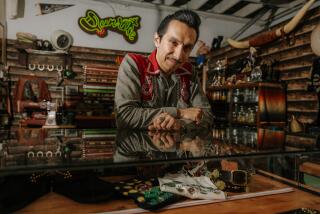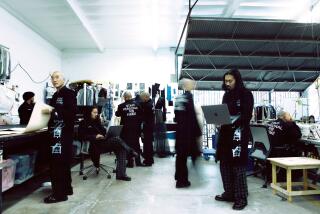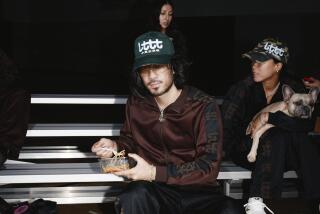Flaunting Its Fibers
- Share via
Augustine Tse is on a roll.
His new designer, Tess Giberson, is getting rave reviews. Sales of his cashmere jogging suits and hand-knit sweaters topped $100 million last year. And Tse Cashmere got a prominent mention in writer-director Nicole Holofcener’s female-buddy movie “Friends With Money.”
But Tse (pronounced “say”) isn’t satisfied. For centuries, China has provided the bulk of the precious cashmere fiber used by storied brands such as Scotland’s Pringle and Italy’s Loro Piana to produce the uber-expensive garments coveted by royalty and Hollywood elite. Now, he said, it is time for China to assume its rightful place as heir to the global cashmere throne.
“Over the next 20 years, the designer labels in Europe will continue to prosper but the production in Europe will be very, very minimal,” said Tse, whose Chinese-made garments are carried at upscale stores such as Henri Bendel and Fred Segal. “The made-in-France or made-in-Italy label will be gone.”
It took decades for Japanese and South Korean automakers and electronics firms to win over America’s pickiest consumers. China is hoping to accelerate that timeline, helped along by globe-trotting entrepreneurs who bring a sense of patriotism to their achievements.
But perceptions die hard, particularly in the status-conscious world of luxury commerce. Michelle Dalton Tyree, a former Women’s Wear Daily editor who bought her first Tse sweater more than a decade ago, said the shift of the luxury cashmere trade to China was a “dirty little secret” that most designers and their customers preferred not to discuss.
“I hate to say it, but they don’t really want to know that,” said Dalton Tyree, whose newly opened La Brea boutique, Iconology, will carry several pieces from Tse’s fall collection.
Tse’s climb from mass to class provides a window into China’s transformation from a poor, isolated country to a manufacturing dynamo.
For centuries, China and neighboring Mongolia, which produce nearly three-quarters of the world’s cashmere, sold almost all their raw fiber to Europe and the United States. Western mills developed the equipment to process the fragile fibers and the Europeans created the premier cashmere brands.
“China made everyone very, very rich,” said Tse, 58, the chief executive of Cashmere House Inc., owner of the Tse Cashmere label.
Kashmir goats thrive in the harsh climate of Xinjiang province, a sparsely populated mountainous region of northwestern China. The hardy goats produce a layer of the downy cashmere as insulation underneath their coarse outer fur, and the fragile fibers are collected by combing the animal. It takes four years for one goat to produce enough cashmere to make a sweater.
Because of its scarcity, the highest-quality white cashmere costs about six times as much as the best wool.
Under the Communists, officials in Beijing controlled the raw cashmere trade, and most of it was sold to foreigners. In the late 1970s, after China began moving toward a market economy, Tse said, Xinjiang provincial officials approached Tang Hsiang Chien, one of Hong Kong’s most powerful industrialists, about becoming a partner in a cashmere factory.
China’s leaders were anxious to create jobs in Xinjiang, home to more than a dozen ethnic groups and a Muslim separatist movement. The late Deng Xiaoping, who spearheaded China’s reforms, gave the green light to the project, which became the country’s first foreign joint venture.
The Chinese government promised Tang his factory would get a steady supply of high-quality raw cashmere and some of the coveted quota it needed to export garments to the United States and Europe. In return, Tse said, Tang’s company agreed to improve the quality of Chinese cashmere so it could compete with European and American products.
Tse, who worked in one of Tang’s Hong Kong companies, was given the daunting task of building the factory in Urumqi, Xinjiang’s capital. The factory site was a swampland, and building materials had to be brought in from Beijing, a nearly four-day train ride. Most of the prospective employees were nomadic tribespeople who had never worked in a factory.
The biggest hurdle was acquiring the know-how and equipment to produce the cashmere. Tse traveled more than half a dozen times to Europe, but the mills there refused to join the project, fearful of doing business with a Communist country and arming a potential competitor. Tse finally found a Japanese cashmere company, Toyo Boshi Kogyo Co., willing to provide technology and training.
Xinjiang Tianshan Wooltex Stock Co., which contained one spinning mill and two knitting factories, opened in 1981 with 1,200 employees. Tse started by producing sweaters for local shops and the government-run Friendship Stores that sold to foreigners.
It took more than a year of transpacific trips before Tse landed his first order from a New York retailer. But by the mid-1980s, he said, Xinjiang Tianshan was the largest supplier of low-priced, private-label cashmere sweaters to U.S. retailers.
Over the next decade, the Chinese domestic cashmere industry exploded and foreigners such as Jeffrey Liebert found it nearly impossible to get their hands on raw cashmere. Most of the Chinese firms had government backing, giving them access to cheap land and utilities and low-priced loans.
“We just couldn’t run around with suitcases full of cash and buy like they could,” said Liebert, who worked for Forte Cashmere Co., one of the leading cashmere processors in the U.S.
Richard Forte, then the third-generation owner of Boston-based Forte, said he “saw the rungs beneath me disappearing.” He switched gears and began helping Chinese cashmere producers sell to the U.S. In 1997, he sold his firm to a British company.
The world was flooded with low-cost cashmere, much of it poor quality or containing wool or other fibers. Many U.S. and European processors closed their doors or shut down their mills and began importing from Asia. Warren Corp., based in Stafford Springs, Conn., is the only surviving cashmere producer in the U.S. It was purchased by Loro Piana in 1988. In 2005, China and Hong Kong accounted for 80% of U.S. cashmere knit imports, up from 66% a decade earlier, according to the Cashmere and Camel Hair Manufacturers Institute.
To survive, Tse needed to pull out of the pack. In the mid-1980s, he moved to Los Angeles and set up Cashmere House, in partnership with two of Tang’s children, Mai and Sandys. His goal was to create a Chinese brand that could compete in the luxury market.
The world of haute couture was not a natural fit for Tse, who confesses to being more comfortable with assembly lines than fashion models.
“I’m just a dumb manufacturer,” said the Hong Kong native, who graduated with a mechanical engineering degree and has spent more than three decades in the textile and apparel business.
But Christina Peng, one of Tse Cashmere’s original designers, said Tse gave her the mandate to do the “unthinkable” with cashmere, a luxury fiber associated with stodgy “blue blood” garments. The company’s first big hit was a soft hooded sweater, or “hoodie,” that flew off the shelf. Pull-on pants followed naturally, along with bathrobes, baby clothes and even a cashmere bikini.
Tse opened mini-boutiques inside upscale stores such as Bergdorf Goodman and Saks Fifth Avenue and eventually opened five free-standing stores in the U.S. He also hired some of the fashion world’s hottest names -- including Narciso Rodriguez and Richard Chai -- to give his line a unique look. Before joining Tse, Giberson worked for Calvin Klein.
By redefining cashmere as a garment that could be worn to a party or the grocery store, Tse Cashmere caught the attention of wealthy party girls and Hollywood celebrities. Madonna bought Tse clothes for her baby. Steven Spielberg stocked up on cashmere jogging suits for his friends. Holofcener received several Tse sweaters as gifts, including a favorite hoodie.
Although 65% to 70% of Tse’s sales are in the U.S., the company’s biggest growth is coming from Europe and Asia. His TseSay brand, a lower-priced line aimed at women in their 20s and 30s, has been a hit in South Korea and Japan. “Chuppies,” or Chinese yuppies, are the next hot market.
Tse still manufactures some garments in Italy, such as a superfine wool twin set that retails for $890. The Italian factory is the only one in the world still using a specialized hosiery machine that can knit that product. But he produces most of his cashmere in China. That allows him to keep prices low, particularly on labor-intensive garments such as his double-faced cashmere coats with hand-sewn seams. A Tse double-faced men’s cashmere jacket costs $2,200, half the price of a comparable garment from Italy.
Selling cashmere turned out to be the easy part. Selling China is proving to be a lot harder. But Tse, who prefers the anonymity of Newport Beach to a tony address in Manhattan, has reluctantly agreed to become a more visible advocate for China’s cashmere industry. He also plans to teach his staff about his brand’s Chinese origins, so they can tell customers how cashmere gets from the mountains of Xinjiang to the store shelf.
“China has spent a lot of effort so they will be perceived as a major player in the world,” he said. “China doesn’t want to be just another subcontractor.”






